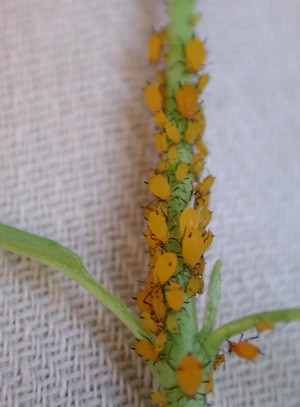Oleander Aphid
Aphis nerii

This aphid colony was found on new shoots of a milkweed vine, Sarcostemma cyanchoides, Phoenix, Arizona on March 1, 2007. The photo is also hosted at Wikicommons where you can find more aphid photos.
Aphididae -- Aphid Family
Oleander Aphid is a misnomer, because the original host for these aphids are milkweeds, the Asclepiadaceae (Apocynaceae). After the exotic oleander was introduced to the Sonoran Desert from the Middle East, this aphid was able to 'jump' hosts because the plants are taxonomically related and thus have similar chemical profiles that the aphid requires.
The bright yellow color is an indication that the aphids have sequestered toxic chemicals from the host, in this case cardiac glycosides - heart poisons - (Rothschild et al., J Insect Physiol. 1970 Jun;16(6):1141-5.). They advertise the fact to potential predators. Parasitic braconid wasps readily parasitize these aphids. Verdins (Auriparus flaviceps) are small insectivorous birds in the Sonoran Desert. I find that they will visit these colonies, eat a few, then move on. Presumably they limit their intake of toxins affirming that the dose makes the poison. These bugs (true bugs) can become quite abundant in the Sonoran Desert on milkweeds such as the ornamental Desert Milkweed, Asclepias subulata. A gardener can knock most of the aphids off with a good hosing of water.